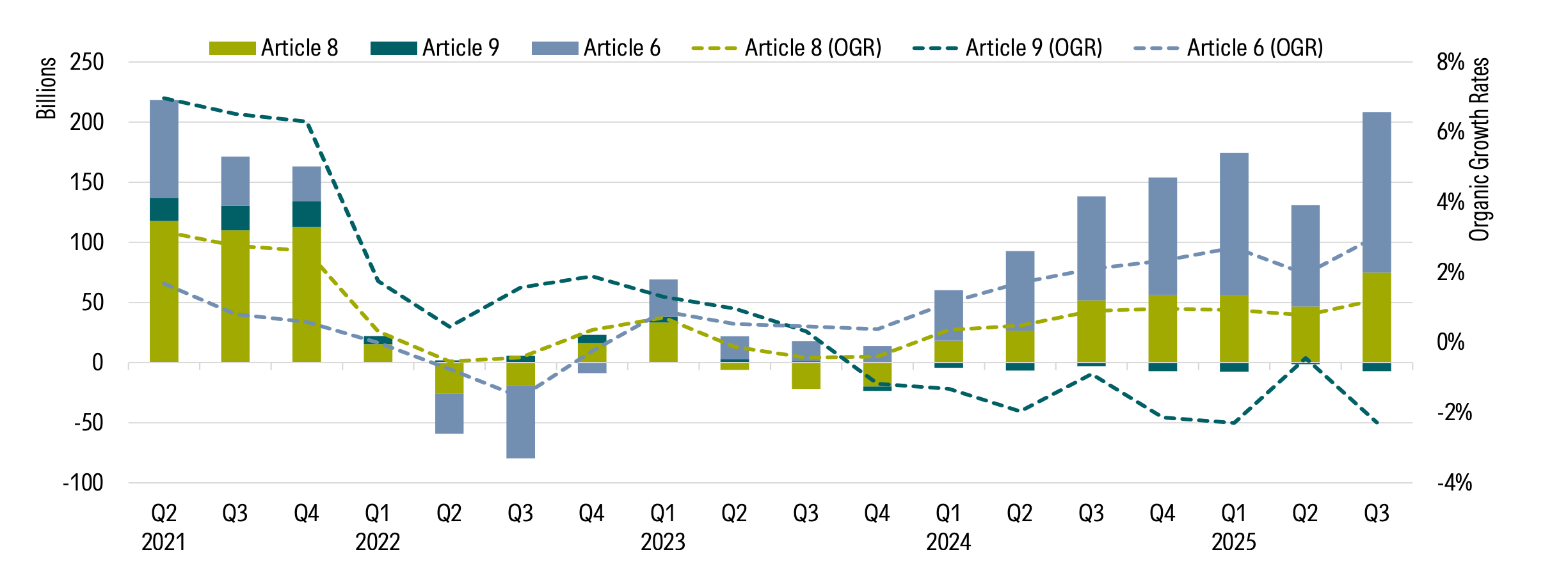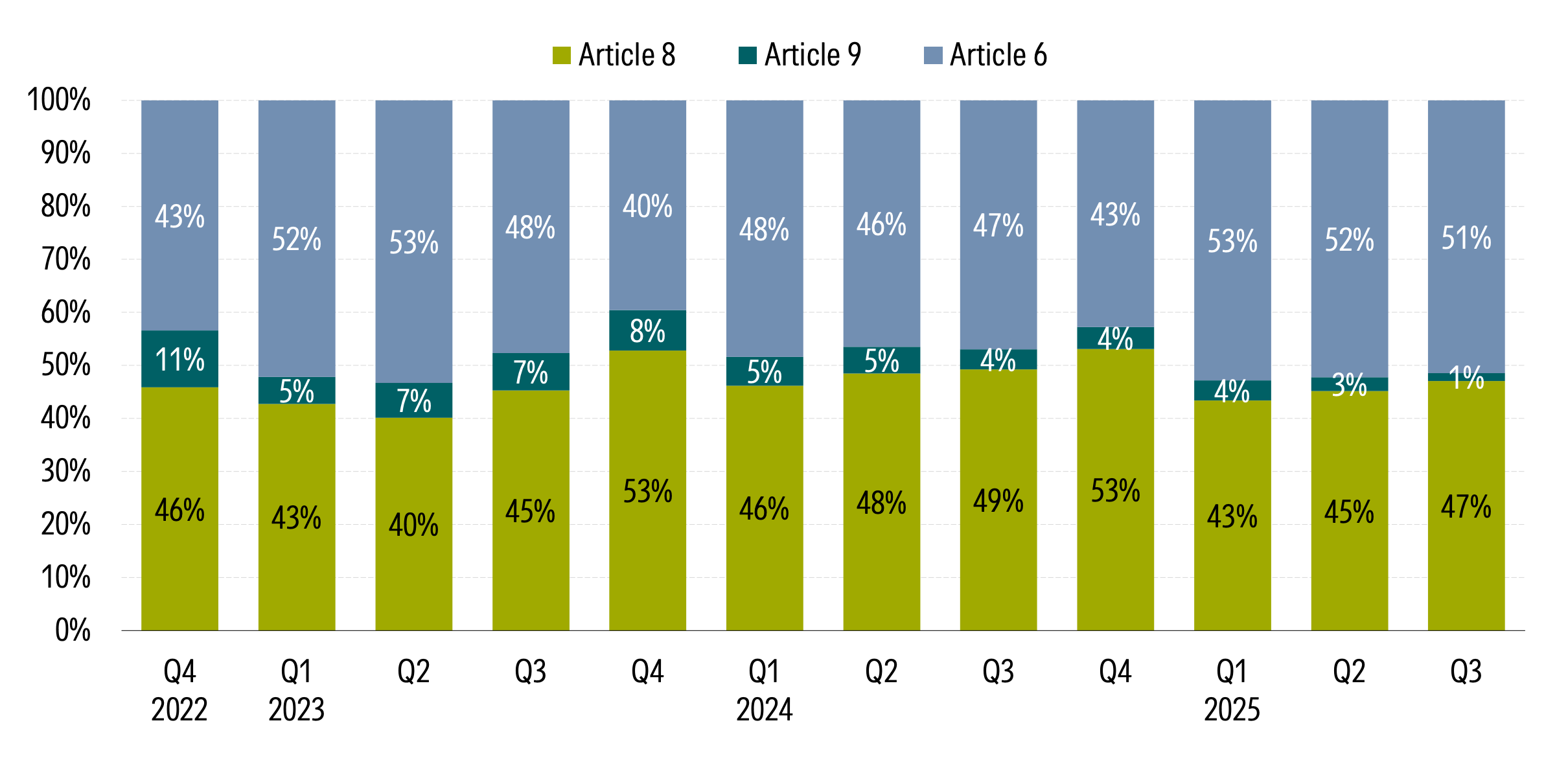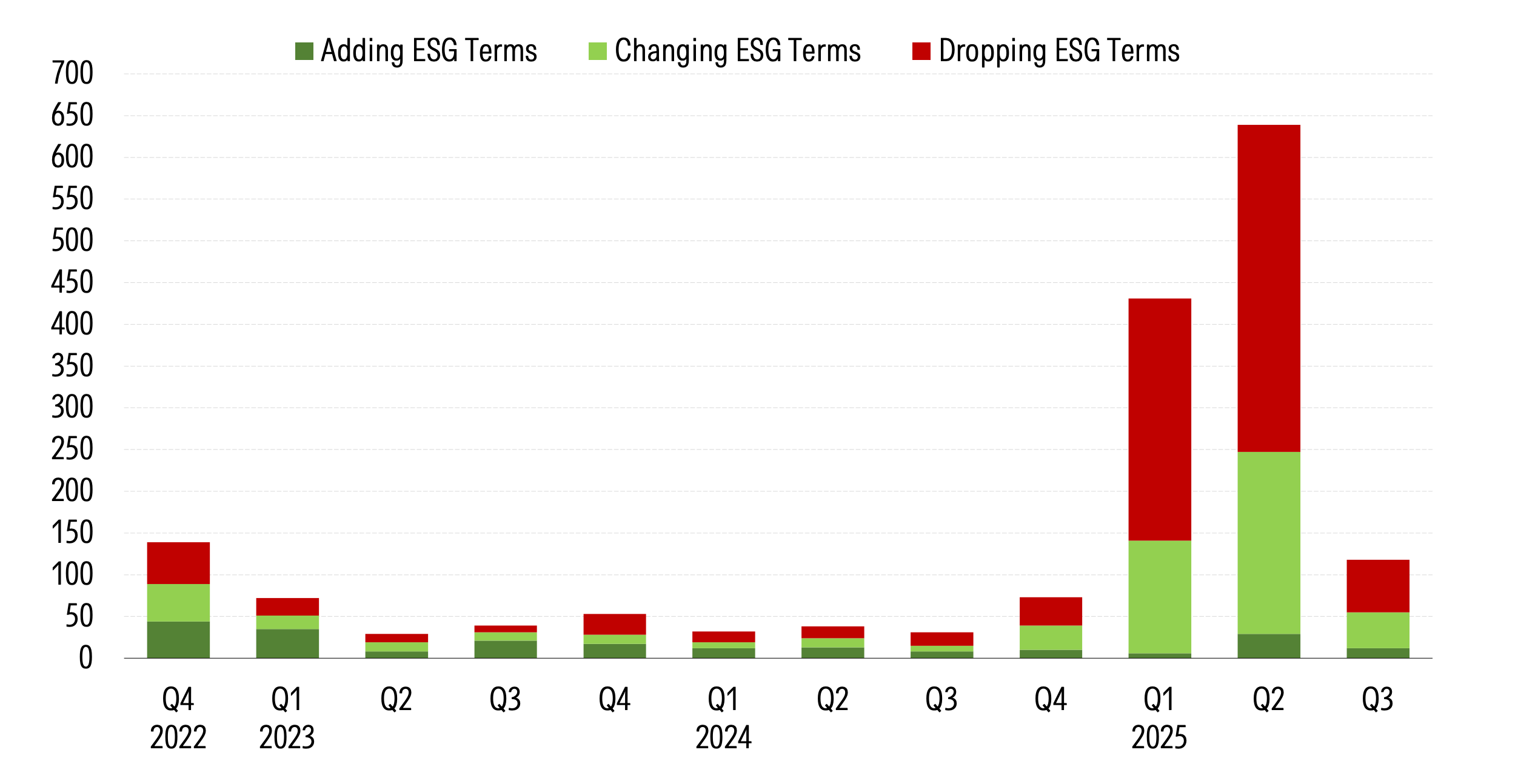7 min read
SFDR Article 8 and 9 Funds: Requirements, Inflows, ESG Risks

On this page
On this page
On this page
On this page
Under the Sustainable Finance Disclosure Regulation, EU asset managers must provide more information on sustainability risks and the impact of investment products. The level of disclosure depends on a product’s classification as an Article 8 or Article 9 fund.
This report provides an update on the landscape of Article 8 and Article 9 funds (excluding money market funds, funds of funds, and feeder funds) as at the end of September 2025, examining aspects such as flows, assets, launches, closures, reclassifications, and fund name changes, as asset managers rushed to comply with the European Securities and Markets Authority’s guidelines on funds using ESG or sustainability-related terms in their names ahead of the May 21 deadline.
Our researchers dissected Article 8 and Article 9 funds with Morningstar’s climate data.
For more in-depth analysis, download the free SFDR funds report.
What Are the Article 8 Fund Requirements?
Article 8 funds promote environmental or social characteristics. Holdings should generally help attain the environmental or social characteristics promoted. In comparison, Article 9 funds have an explicit sustainable-investment objective.
Funds that promote an environmental characteristic must additionally disclose alignment with the EU Taxonomy of Sustainable Activities. These funds also must indicate if they invest a proportion in environmentally sustainable investments.
All Article 8 and Article 9 products must disclose if they consider Principal Adverse Impact indicators. These capture the potential negative impact of financial products on:
- Environmental, social, and employee matters
- Respect for human rights
- Anticorruption and antibribery matters
The Sustainable Finance Disclosure Regulation outlines 64 indicators. Of these, 14 are currently mandatory (on a comply-or-explain basis) for corporate investments:
- Greenhouse gas emissions
- Carbon footprint
- Greenhouse gas intensity of investee companies
- Exposure to companies active in the fossil fuel sector
- Share of nonrenewable energy consumption production
- Energy consumption intensity per high impact climate sector
- Activities negatively affecting biodiversity-sensitive areas
- Emissions to water
- Hazardous waste ratio
- Violations of the UN Global Compact principles and Organisation for Economic Co-operation and Development Guidelines for Multinational Enterprises
- Lack of processes and compliance mechanisms to monitor compliance
- Unadjusted gender pay gap
- Board gender diversity
- Exposure to controversial weapons
Two are mandatory for sovereign and supranational issuers:
- Greenhouse gas intensity of investee countries
- Number of investee countries subject to social violations
And two are mandatory for real estate assets:
- Exposure to real estate assets involved in the extraction, storage, and transport of fossil fuels
- Exposure to energy-inefficient real estate assets
Article 8 Funds Attract Higher Inflows, but Article 9 Funds Continue to Face Outflows
In the third quarter of 2025, Article 8 funds attracted an estimated EUR 75 billion of net inflows, compared with the restated EUR 46.7 billion recorded in the previous quarter. This is the highest recorded net inflows for the category since the fourth quarter of 2021. Article 8 fund flows represented 37% of overall EU fund flows in the third quarter of 2025.
For the eighth consecutive quarter, Article 9 funds experienced outflows, resulting in an estimated EUR 7.1 billion in losses over the last three months, following restated outflows of EUR 1.4 billion in the second quarter. The Q3 redemptions were in line with those of the two prior quarters, indicating a persistent loss of investor appetite for these products, even as renewable energy stocks (popular in Article 9 funds) showed signs of recovery.
By contrast, Article 6 funds attracted approximately EUR 134 billion in new capital in the third quarter, marking the highest recorded net inflows for the category since the introduction of the SFDR in March 2021. Article 6 funds remain the dominant category in terms of flows, despite accounting for 41% of EU fund assets.
Quarterly Flows Into Article 8 and Article 9 Funds Versus Article 6 Funds (EUR Billion) and Organic Growth Rates (%)

Source: Morningstar Direct. Data as of September 2025. Based on SFDR data collected from prospectuses of 98% of funds available for sale in the EU, excluding money market funds, funds of funds, and feeder funds.
Inflows into Article 8 and Article 6 funds in the third quarter were supported by market appreciation. For context, the Morningstar Global Market Index gained 7.6% over the period, while the Morningstar Global Corporate Bond Index rose by 1.6%. Calculated as net flows relative to total assets at the start of the period, the organic growth rate (OGR) of Article 8 funds increased to 1.2%, while that of Article 6 funds reached a record high of 3%. In contrast, Article 9 funds saw their OGR decline to -2.3%, approaching the category’s previous low recorded in the first quarter of the year.
What Proportion of Assets Are in Article 8 Funds?
Looking at market share by number of funds, Article 8 ranks as the second-largest category, with 12,046 funds, representing 48.2% of the funds in scope for SFDR. Article 9 funds remain the smallest category, accounting for a modest 3.1% with 1,031 funds, while Article 6 funds hold the largest share, at 47.7%, with 12,046 funds.
How Many New Article 8 Funds Launched Last Quarter?
In the third quarter of the year, 131 new Article 8 and Article 9 funds hit the market. This is lower than the restated 202 new Article 8 or Article 9 products launched in the prior quarter. As we continue to analyze the data and identify additional launches, numbers could be adjusted in the next report.
The newly launched Article 8 and Article 9 funds accounted for nearly 49% of all funds launched in the EU — almost on par with the 48% seen in the previous quarter — confirming a continued downward trend compared to last year.Quarterly Breakdown of Fund Launches

Source: Morningstar Direct. Data as of September 2025. Based on SFDR data collected from prospectuses on 98% of funds available for sale in the EU, excluding money market funds, funds of funds, and feeder funds.
Fixed Income Continue to Dominate Article 8 Fund Inflows
Fixed income strategies continued to dominate Article 8 fund inflows in the third quarter. These garnered EUR 49 billion, while Article 6 fixed income funds attracted EUR 34 billion. Fixed income has consistently demonstrated resilience, as highlighted in another report, "Global Sustainable Fund Flows: Q3 2025 in Review." Article 9 fixed income funds gained a modest EUR 0.7 billion, up from the EUR 0.4 billion inflows recorded in the previous quarter and broadly consistent with first quarter levels.
Meanwhile, flows into Article 8 equity strategies showed a modest recovery, with EUR 4.3 billion in net subscriptions in the third quarter, following EUR 9.8 billion in outflows in the previous quarter. But these new equity fund subscriptions are in sharp contrast with the EUR 76 billion of new money poured into Article 6 equity funds, while Article 9 equity funds bled EUR 7.9 billion.
Net Flows Into Article 8, Article 9, and Article 6 Funds Per Asset Class (EUR Billion)
.png?format=webp&auto=webp&disable=upscale)
Source: Morningstar Direct. Data as of September 2025. Based on SFDR data collected from prospectuses of 98% of funds available for sale in the EU, excluding money market funds, funds of funds, and feeder funds.
Meanwhile, investors withdrew just over EUR 10 billion from equity funds classified under both Article 8 and Article 9 during the second quarter, while Article 6 equity funds garnered close to USD 53 billion, less than in the prior quarter (EUR 76 billion).
Renaming Activity Slows Following ESMA Fund-Naming Guidelines Deadline
After a busy first half of the year, during which asset managers rushed to implement the EU’s ESMA fund naming guidelines ahead of the May 21 deadline, fund renaming activity has since slowed. In the third quarter of 2025, we identified a total of 121 renamed Article 8 and Article 9 funds. Focusing on Article 8 funds, 63 removed ESG-related terms from their names.
Examples include a series of JSS bond and equity funds, which dropped the term “sustainable”, but maintained their investment objectives. KBC Perspective World Timing 100-1 and KBS Perspective Global Double Timing USD 100-1 Advanced dropped the words “Responsible Investing”, leaving their underlying strategies unchanged. Out of the 63 funds that dropped ESG-related terms in the past three months, almost all (61) were actively managed.
The amended MiFID II directive requires financial intermediaries to consider clients’ sustainability preferences when assessing suitability. If clients express interest in sustainable investments, they must accommodate.

Source: Morningstar Direct. Data as of September 2025. Based on 2.252 Article 8 funds that have added, dropped, or changed ESG- and sustainability-related terms in the legal names since 2022. Including money market funds, funds of funds, and feeder funds.
The European ESG template, or EET, supports this process. As of March 2025, Morningstar had collected EET data on 22,944 funds, including 11,908 Article 8 funds.
Morningstar Direct covers key European ESG template data points, including:
- SFDR minimum or planned sustainable investments. This represents the minimum percentage of portfolio investments deemed sustainable but not taxonomy-aligned.
- SFDR minimum or planned taxonomy-aligned sustainable investments. This represents the minimum percentage of the portfolio that aligns with the EU Taxonomy.
- PAI consideration, indicating whether a product considers principal adverse impact in its investments.
The number of funds that replaced ESG-related terms with others also declined to 43 from the restated sum of 353 seen over the first half of the year, and almost all (41) were active strategies.
For example, HI-Climate Transition Multi-Faktor Aktien Global-Fonds replaced the word “sustainable” with the new term “climate transition”. EDM International Sustainable Global Equity Fund replaced the word “impact” with “sustainable” in its name, while adhering to its investment strategy, under which only companies with an ESG score of at least 50 (out of 100) are eligible for investment, according to the fund’s proprietary ESG scoring system.
Go Deeper into Article 8 and 9 Funds
For a more detailed breakdown, download the Article 8 and 9 research report. The full report covers:
- Top 20 asset managers by Article 8 fund assets.
- The 20 largest Article 8 funds.
- The asset class mix of Article 8 funds.
- The 10 Article 8 funds with the highest inflows and outflows.


